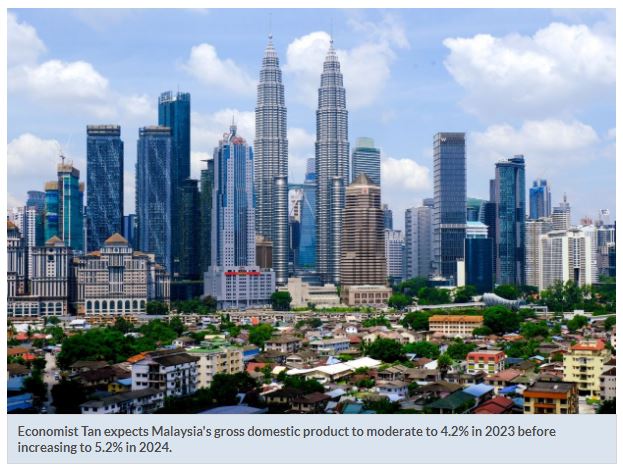Malaysia: Domestic demand to drive growth
PETALING JAYA: Strong private domestic demand and the resumption of investment projects will be Malaysia’s main growth drivers this year, says Asean+3 Macroeconomic Research Office (Amro) deputy group head and senior economist, Anthony Tan.
Tan expects the country’s gross domestic product (GDP) to moderate to 4.2% in 2023 before increasing to 5.2% in 2024.
“Domestic demand will continue to drive Malaysia’s growth, underpinned by pent-up consumption. It is also due to the consolidation that is taking place in the public sector.
“Apart from this, the resumption of investment projects, particularly in the electrical and electronics sector, telecommunication and data centres which were delayed due to mobility restrictions during the Covid-19 pandemic, will also support economic growth,” he said during the press conference for the launch of Amro’s flagship report, the “Asean+3 Regional Economic Outlook 2023”.
While Tan cautioned against moderating external demand as a potential headwind for Malaysia, the better-than-expected growth numbers from the United States and Europe will likely cushion the impact.
“This is a silver lining to weaker external demand.
“If you look at this year, the growth forecast for these major advanced economies is still quite positive,” he said.
Malaysia’s inflation rate is projected to ease to 3.2% in 2023 from 3.3% last year.
Amro chief economist Hoe Ee Khor said the country managed to bounce back quite rapidly from the pandemic.
This is given its highly diversified economy that saw Malaysia benefiting from the terms of trade last year.
He remains positive about the country’s growth prospects in the longer term, in part due to the high inflows of foreign direct investment.
“At the moment, because of the pandemic, Malaysia’s fiscal deficits are quite high, but the country has a medium-term consolidation plan to bring the fiscal deficit down to 3.5% by 2025.
“So far, they are on track in achieving the target. As such, we are not particularly concerned about the debt issue of the country,” said Khor.
On the whole, he said GDP growth in Asean+3 is expected to come in at 4.6% this year and 4.5% in 2024.
“On the other hand, GDP growth for the Asean region is expected to reach 4.9% and 5.2% for 2023 and 2024 respectively.
“China’s GDP is expected to recover very strongly this year by 5.5%. The Asean+3 region is expected to remain resilient, notwithstanding the strong headwinds of weaker external demand and tighter global financial conditions.
“The boost in tourism and intraregional trade from the rebound in China’s economy will help mitigate softer external demand from the United States and Europe,” said Khor.
Asean+3 consists of the 10 Asean member countries as well as China, Japan and South Korea.
Khor also projects inflation for Asean+3 to moderate from 6.5% last year to 4.7% in 2023, before normalising to 3% next year.
Inflation for the Asean region is likely to decline to 5.7% this year from 7.9% in 2022.
“The numbers are still relatively elevated and central banks are still very concerned because most of the figures are still above inflation targets.
“Hence, central banks may have to keep monetary policy relatively tight until inflation is on a downtrend and back to pre-pandemic levels,” he said.
Khor noted a spike in energy prices caused by an escalation of the Ukraine crisis, or weaker-than-expected recovery in China, or a sharp slowdown in the United States, could dampen the region’s growth prospects.
“Policymakers need to remain vigilant and continue to rebuild policy buffers. They also need to remain flexible to extend additional support to the economy, if necessary,” he said.
Source: https://www.thestar.com.my/business/business-news/2023/04/07/domestic-demand-to-drive-growth


 English
English




